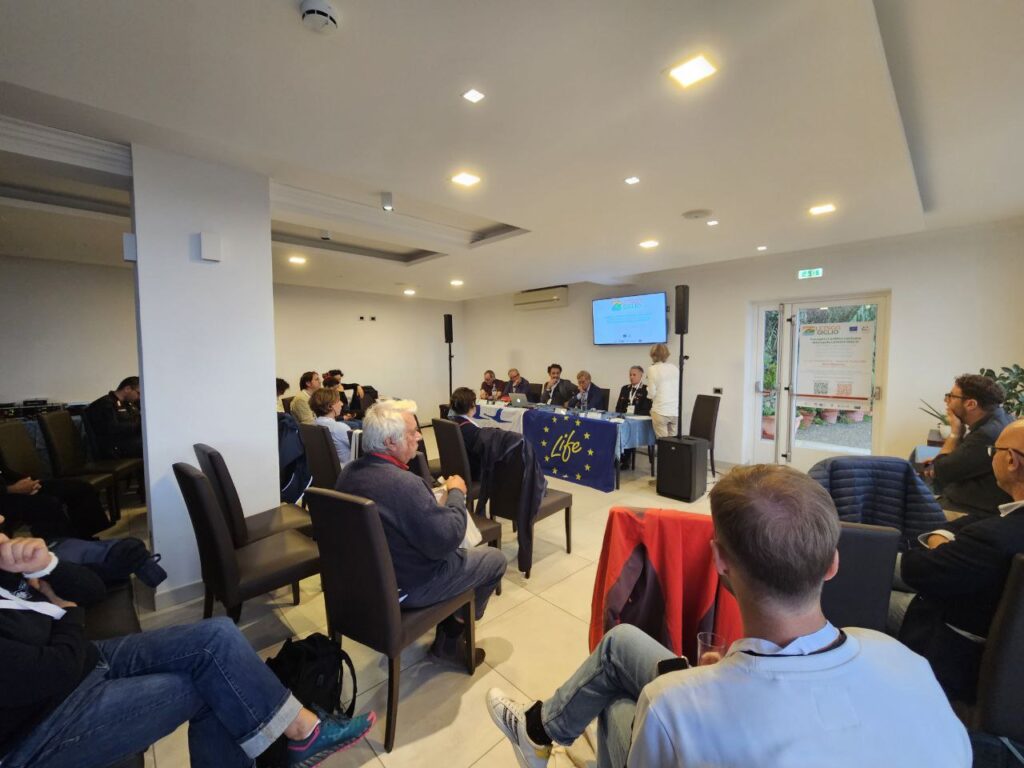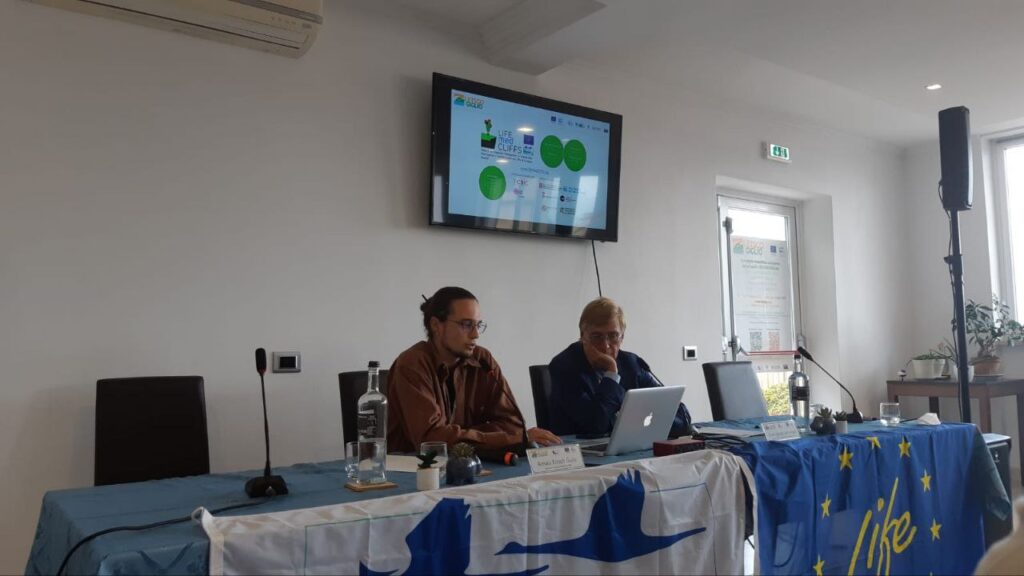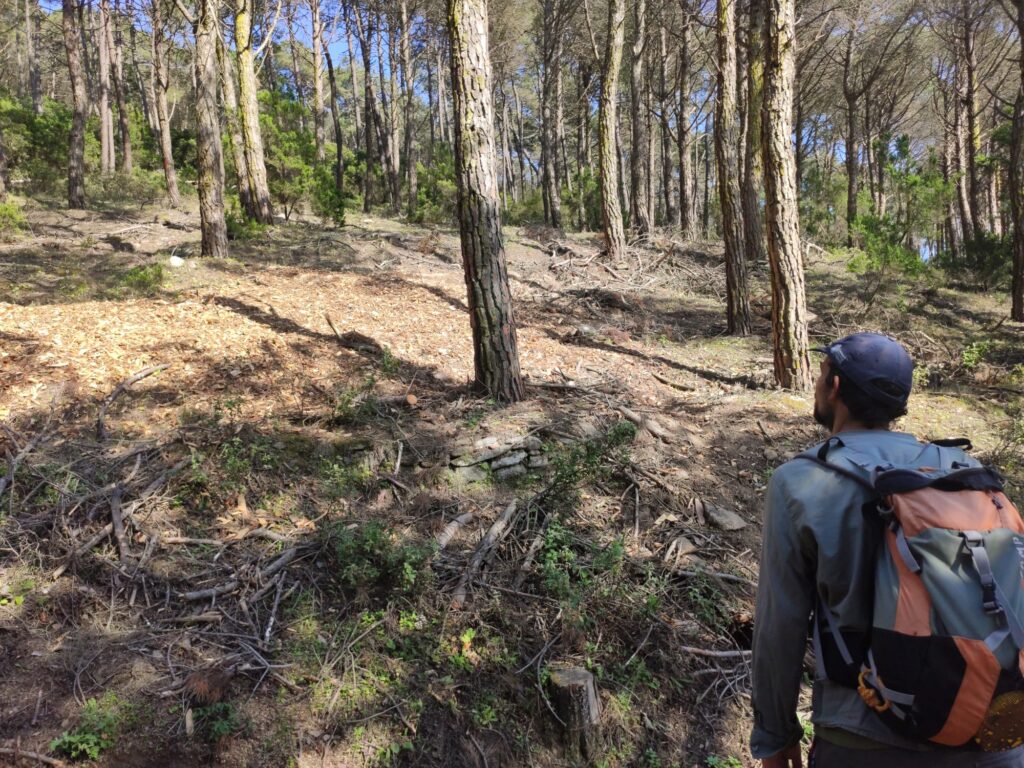
Recently, one of the LIFE medCLIFFS technicians had the honour to participate at the closure congress of the LIFE LETSGO Giglio project, a transforming initiative co-funded by the European Union. This project has contributed to restoring the natural habitats and biodiversity of the Giglio island, in Toscana (Italy). LIFE LETSGO Giglio focused on invasive species management and the rehabilitation of essential habitats, including the Habitat of Community Interest 1240 (Mediterranean cliffs with endemic Limonium species).
 Round table with Giampiero Samuri (President of the Parco Nazionale Arcipelago Toscano), Andrea Monaco (Instituto Superiore per la Protezione e la Ricerca Ambientale), Stefano Cipriani (Commander of the National Park Carabineri), Antonio canu (WWF Italia), Umberto Mazzantini (Legambiente).
Round table with Giampiero Samuri (President of the Parco Nazionale Arcipelago Toscano), Andrea Monaco (Instituto Superiore per la Protezione e la Ricerca Ambientale), Stefano Cipriani (Commander of the National Park Carabineri), Antonio canu (WWF Italia), Umberto Mazzantini (Legambiente).
 Presentation of the LIFE medCLIFFS project at the conference in Giglio with Giampiero Samuri (President of the Parco Nazionale Arcipelago Toscano) and Arnau Bosch Guiu (Botanical Institute of Barcelona).
Presentation of the LIFE medCLIFFS project at the conference in Giglio with Giampiero Samuri (President of the Parco Nazionale Arcipelago Toscano) and Arnau Bosch Guiu (Botanical Institute of Barcelona).
In the same way, as in the Natural Park of Cap de Creus, removal actions of sour-fig (Carpobrotus spp.) were also conducted in Giglio, a very widespread species in the island which forms monospecific carpets covering and erasing all native vegetation. 2.5 hectares of sour-fig were removed manually, and stacked into piles. These were covered with geotextile fabrics so they could dry out completely during summer. At the removal zones, we could observe with satisfaction how the native flora started to regenerate over the dry sour-fig remains, especially by the presence of a population of one of the Limonium species endemic to the archipelago (Limonium sommierianum). Despite these positive results, there were several sour-fig sprouts which will be monitored and controlled during the coming years.
 Sour-fig (Carpobrotus sp.) remotion area in Punta Capel Rosso (Giglio, Itàlia), where the native flora recovery, with plants of silver ragwort (Jacobaea maritima), lentisk (Pistacia lentiscus), immortelle (Helichrysum italicum) and friar’s cowl (Arisarum vulgare) over the dry sour-fig remains (ground dark area).
Sour-fig (Carpobrotus sp.) remotion area in Punta Capel Rosso (Giglio, Itàlia), where the native flora recovery, with plants of silver ragwort (Jacobaea maritima), lentisk (Pistacia lentiscus), immortelle (Helichrysum italicum) and friar’s cowl (Arisarum vulgare) over the dry sour-fig remains (ground dark area).
 Limonium sommierianum, endemic to the Parco Nazionale Arcipelago Toscano, growing in the sour-fig (Carpobrotus sp.) remotion area at Punta Capel Rosso (Giglio, Italy), right next to a juvenile sour-fig plant.
Limonium sommierianum, endemic to the Parco Nazionale Arcipelago Toscano, growing in the sour-fig (Carpobrotus sp.) remotion area at Punta Capel Rosso (Giglio, Italy), right next to a juvenile sour-fig plant.
The project also contemplated the management of some invasive animal species such as the mouflon (Ovis orientalis), rabbit (Oryctolagus cuniculus) and the California turtle (Trachemys scripta). The three turtle specimens on the island were captured, sterilized and relocated to an animal sanctuary. In the rabbit case, they only managed relative control, as only a few specimens were captured. The mouflon eradication was highly controversial in Italy though, and it turned into a debate at a national level. Some animal-rights associations outside the island defended the mouflon’s right to remain on the island. After protests, sues and political debates, there was an agreement between the Parco Nazionale Arcipelago Toscano, the animal-rights association Lega Anti Vivisezione (LAV) and the World Wide Fund for Natures (WWF) to continue with the eradication without hunting them, instead, they relocated them to several animal sanctuaries in Italy. Nevertheless, during the congress, there was a highlight on the contradiction about the fight where about 60 mouflons were hunted in Giglio to preserve the biodiversity, whereas, on the island of Elba, this number increased to 800, and over a thousand in all of Italy. This polemic highlighted the diversity of sensibility when we try to manage invasive species and the importance of maintaining good communication to ensure solid social support in projects of this kind.
This project also included the Discoglossus sardus habitat restoration, an amphibian endemic to the archipelago, of Sardinia and Corsica. They created several artificial ponds which seem to work well, as there have been several observations of this species in them.
 Visit during the LIFE LETSGO Giglio congress at the artificial ponds to improve the conservation status of the Discoglossus sardus.
Visit during the LIFE LETSGO Giglio congress at the artificial ponds to improve the conservation status of the Discoglossus sardus.
Finally, the project also restored the semi-natural pinewoods, as the pine species (Pinus pinea, Pinus pinaster, Pinus halepensis) were introduced to the island. They conducted clearings in these pinewoods to improve the safety of the inhabitants, make sustainable use of the forest and promote the regeneration of autochthonous species, e.g. the holy oak (Quercus ilex).
 Restoration zone of a semi-natural pinewood to promote the renewal of autochthonous forests.
Restoration zone of a semi-natural pinewood to promote the renewal of autochthonous forests.
This project has established a precedent of good practices in the management of invasive species and habitat restoration, a model that will be used as a guide for future conservation efforts. LIFE medCLIFFS celebrates the positive results obtained by the LIFE LETSGO Giglio project and we support their chosen and performed actions, despite the difficulties they encountered along the way.
https://www.lifegogiglio.eu/en/


 Round table with Giampiero Samuri (President of the Parco Nazionale Arcipelago Toscano), Andrea Monaco (Instituto Superiore per la Protezione e la Ricerca Ambientale), Stefano Cipriani (Commander of the National Park Carabineri), Antonio canu (WWF Italia), Umberto Mazzantini (Legambiente).
Round table with Giampiero Samuri (President of the Parco Nazionale Arcipelago Toscano), Andrea Monaco (Instituto Superiore per la Protezione e la Ricerca Ambientale), Stefano Cipriani (Commander of the National Park Carabineri), Antonio canu (WWF Italia), Umberto Mazzantini (Legambiente). Presentation of the LIFE medCLIFFS project at the conference in Giglio with Giampiero Samuri (President of the Parco Nazionale Arcipelago Toscano) and Arnau Bosch Guiu (Botanical Institute of Barcelona).
Presentation of the LIFE medCLIFFS project at the conference in Giglio with Giampiero Samuri (President of the Parco Nazionale Arcipelago Toscano) and Arnau Bosch Guiu (Botanical Institute of Barcelona). Sour-fig (Carpobrotus sp.) remotion area in Punta Capel Rosso (Giglio, Itàlia), where the native flora recovery, with plants of silver ragwort (Jacobaea maritima), lentisk (Pistacia lentiscus), immortelle (Helichrysum italicum) and friar’s cowl (Arisarum vulgare) over the dry sour-fig remains (ground dark area).
Sour-fig (Carpobrotus sp.) remotion area in Punta Capel Rosso (Giglio, Itàlia), where the native flora recovery, with plants of silver ragwort (Jacobaea maritima), lentisk (Pistacia lentiscus), immortelle (Helichrysum italicum) and friar’s cowl (Arisarum vulgare) over the dry sour-fig remains (ground dark area). Limonium sommierianum, endemic to the Parco Nazionale Arcipelago Toscano, growing in the sour-fig (Carpobrotus sp.) remotion area at Punta Capel Rosso (Giglio, Italy), right next to a juvenile sour-fig plant.
Limonium sommierianum, endemic to the Parco Nazionale Arcipelago Toscano, growing in the sour-fig (Carpobrotus sp.) remotion area at Punta Capel Rosso (Giglio, Italy), right next to a juvenile sour-fig plant. Visit during the LIFE LETSGO Giglio congress at the artificial ponds to improve the conservation status of the Discoglossus sardus.
Visit during the LIFE LETSGO Giglio congress at the artificial ponds to improve the conservation status of the Discoglossus sardus. Restoration zone of a semi-natural pinewood to promote the renewal of autochthonous forests.
Restoration zone of a semi-natural pinewood to promote the renewal of autochthonous forests.
